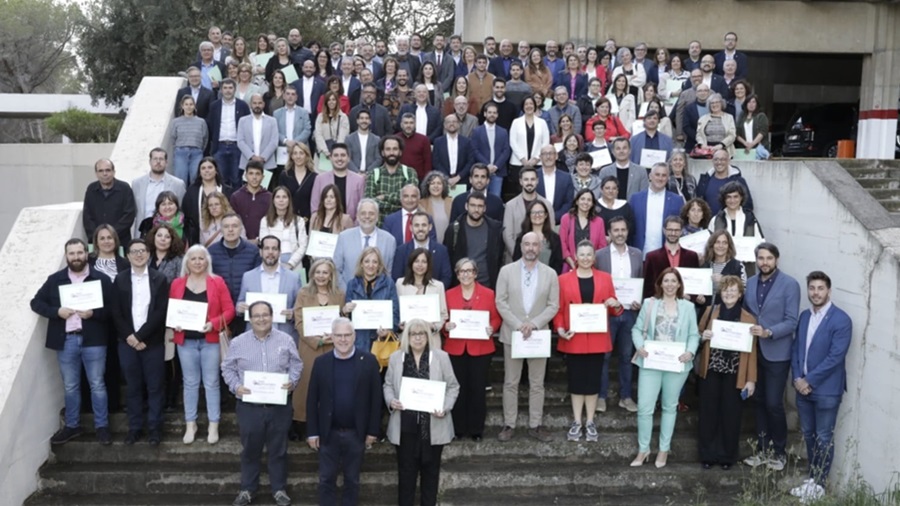The UAB awards the Infoparticipa Seal to the transparency of 129 public administrations
The UAB's ComSET research group (Comunicació Sonora, Estratègica i Transparència) held an institutional event yesterday to award the Infoparticipa Seal to 129 local administrations in Catalonia in recognition of the communication transparency of their institutional websites.

Despite the positive evolution - in the first edition in 2013, only 48 city councils were awarded; this year, there have been 116 - researchers conclude that Catalonia does not overcome the low levels of transparency, given that, after eleven editions, it has not yet been possible to award the distinction to 20% of Catalonia's city and town councils. This year, in addition, the Infoparticipa Seal has been awarded to ten county councils and to the provincial councils of Barcelona, Girona and Tarragona. The 52 indicators on which the evaluation of the websites is based have been updated in this eleventh edition: despite the higher level of demand, the results are maintained, but with a slight decrease.
At the award ceremony, UAB Rector Javier Lafuente congratulated the award-winning institutions, praised the Infoparticipa Seal as "a reference" in the field of information transparency and affirmed that the "university must be at the service of society" and, in this sense, these awards "must help make more visible" the work carried out by public administrations. The director of the ComSET research group, Armand Balsebre, stressed that transparency "is closely related to citizens' trust in their institutions".
The event also included a presentation by Juan Luis Manfredi, Prince of Asturias Professor at Georgetown University, who spoke on the new challenges of transparency and accountability. According to Manfredi, transparency "is not a milestone that is reached but a learning process" that must be constantly renewed. The lecturer also made a claim for local media and the collaboration of administrations with universities.
Indicators
The 52 indicators established by ComSET are based on the 2013 Transparency Law and respond to the following basic questions: who are the political representatives, how do they manage collective resources, how do they manage economic resources, what information do they provide about the municipality and the management of collective resources, and what tools do they offer for citizen participation.
This year these indicators have been modified to raise the level of qualitative requirements. Aspects referring to the publication of the code of ethics, court rulings, access to the information request form, and the report on the requests received and their resolution have been added. It is required that the remunerations and declarations of assets and activities of the elected officials be shown individually and in the space of each political responsible. Special attention has also been paid to both institutional and activity agendas, as well as to anonymisations and the full publication of mayoral decrees. Moreover, the indicator is not validated if the information is not fully updated, comprehensible and easy to find.
Un consell certificador analitza els resultats recollits pel grup ComSET i concedix l'atorgament i les distincions. Per obtenir el Segell Infoparticipa, en el cas de les localitats amb més de 50.000 habitants s'exigeix un 95 % d'indicadors positius; els municipis de 10.001 a 50.000 habitants requereixen un mínim del 90 %; entre els 5.001 i els 10.000 habitants, un 85 %; entre els 1.001 i els 5.000 habitants, un 80%, i finalment, en el cas dels municipis amb menys de 1.000 habitants, s'atorga a partir del 75 % d'indicadors positius. Quant als consells comarcals i les diputacions, s'atorga el Segell Infoparticipa a les institucions que assoleixen un mínim d'un 85 % d'indicadors positius, independentment de la població.
A certifying council analyses the results collected by the ComSET group and awards the distinctions. To obtain the Infoparticipa Seal, in the case of localities with more than 50,000 inhabitants, 95% of positive indicators are required; municipalities with 10,001 to 50,000 inhabitants require a minimum of 90%; between 5,001 and 10,000 inhabitants, 85%; between 1,001 and 5,000 inhabitants, 80%; and finally, in the case of municipalities with less than 1,000 inhabitants, it is awarded on the basis of 75% of positive indicators. As for county councils and provincial councils, the Infoparticipa Seal is awarded to those institutions that achieve a minimum of 85% of positive indicators, regardless of population size.
Results
This eleventh edition of the awards corresponds to the year 2023. Of the 947 municipalities in Catalonia, 116 have obtained the Infoparticipa Seal. There are 17 that have achieved 100% positive indicators: Arenys de Munt, Barcelona, Calafell, Els Hostalets de Pierola, Esplugues de Llobregat, Fonollosa, L'Aldea, Manresa, Mataró, Olesa de Montserrat, Premià de Dalt, Salou, San Climent de Llobregat, Sant Feliu de Llobregat, Sant Quirze del Vallès, and Vic.
The ten distinguished county councils are those of Anoia, Alt Penedès, Baix Ebre, Baix Llobregat (the only one with 100% positive indicators), Berguedà, Gironès, Maresme, Moianès, Vallès Occidental and Vallès Oriental.
The 129 award-winning administrations, many of which have revalidated the Seal year after year, represent an example of good practices in transparency and are leading institutions, given that the total number of approved municipalities is 202 out of the 947 in Catalonia. The municipalities of the demarcation of Lleida are the ones that achieve more discreet results.
This year, in addition, four extraordinary prizes were awarded for the quality of news writing on the websites of the town councils of Canovelles, Castelldefels and Olesa de Montserrat, and of the Vallès Oriental county council.
The UAB, with Sustainable Development Goals
Peace, justice and strong institutions
Sustainable cities and communities